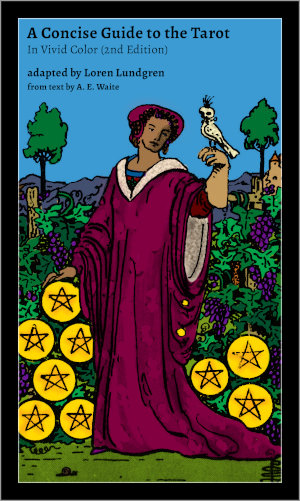Tarot Reading john married;have good marriage ; have a child; his parents told him good things for me; 10 7 1968
Reading Performed 02/05/2013 at 10:05 AM
Click or scroll down for the meaning of each position and the interpretation of its card.
Visual Layout
The Meanings of these Tarot Cards
This Covers You
This card gives the influence which is affecting the person or matter of inquiry generally, the atmosphere of it in which the other currents work.
This Crosses You
It shows the nature of the obstacles in the matter. If it is a favourable card, the opposing forces will not be serious, or it may indicate that something good in itself will not be productive of good in the particular connexion.
The Empress from the Ancient Tarot of Lombardy Deck
A. E. Waite's Secondary Meanings
The Empress, who is sometimes represented with full face, while her correspondence, the Emperor, is in profile. As there has been some tendency to ascribe a symbolical significance to this distinction, it seems desirable to say that it carries no inner meaning. The Empress has been connected with the ideas of universal fecundity and in a general sense with activity.
Related Posts
This Crowns You
It represents (a) the Querent €™s aim or ideal in the matter; (b) the best that can be achieved under the circumstances, but that which has not yet been made actual.
This is Beneath You
It shows the foundation or basis of the matter, that which has already passed into actuality and which the Significator has made his own.
This is Behind You
It gives the influence that is just passed, or is now passing away.
This is Before You
It shows the influence that is coming into action and will operate in the near future.
Your Self
Signifies the person or thing about which the question has been asked, and shows its position or attitude in the circumstances.
Page of Clubs from the Ancient Tarot of Lombardy Deck
Related Posts
Your House
Your environment and the tendencies at work therein which have an effect on the matter €”for instance, your position in life, the influence of immediate friends, and so forth.
The Fool from the Ancient Tarot of Lombardy Deck
A. E. Waite's Secondary Meanings
The Fool, Mate, or Unwise Man. Court de Gebelin places it at the head of the whole series as the zero or negative which is presupposed by numeration, and as this is a simpler so also it is a better arrangement. It has been abandoned because in later times the cards have been attributed to the letters of the Hebrew alphabet, and there has been apparently some difficulty about allocating the zero symbol satisfactorily in a sequence of letters all of which signify numbers. In the present reference of the card to the letter Shin, which corresponds to 200, the difficulty or the unreason remains. The truth is that the real arrangement of the cards has never transpired. The Fool carries a wallet; he is looking over his shoulder and does not know that he is on the brink of a precipice; but a dog or other animal--some call it a tiger--is attacking him from behind, and he is hurried to his destruction unawares. Etteilla has given a justifiable variation of this card--as generally understood--in the form of a court jester, with cap, bells and motley garb. The other descriptions say that the wallet contains the bearer's follies and vices, which seems bourgeois and arbitrary.
Your Hopes and Fears
The Final Result
The culmination which is brought about by the influences shewn by the other cards that have been turned up in the divination.
Wheel of Fortune from the Ancient Tarot of Lombardy Deck
A. E. Waite's Secondary Meanings
The Wheel of Fortune. There is a current Manual of Cartomancy which has obtained a considerable vogue in England, and amidst a great scattermeal of curious things to no purpose has intersected a few serious subjects. In its last and largest edition it treats in one section of the Tarot; which--if I interpret the author rightly--it regards from beginning to end as the Wheel of Fortune, this expression being understood in my own sense. I have no objection to such an inclusive though conventional description; it obtains in all the worlds, and I wonder that it has not been adopted previously as the most appropriate name on the side of common fortune-telling. It is also the title of one of the Trumps Major--that indeed of our concern at the moment, as my sub-title shews. Of recent years this has suffered many fantastic presentations and one hypothetical reconstruction which is suggestive in its symbolism. The wheel has seven radii; in the eighteenth century the ascending and descending animals were really of nondescript character, one of them having a human head. At the summit was another monster with the body of an indeterminate beast, wings on shoulders and a crown on head. It carried two wands in its claws. These are replaced in the reconstruction by a Hermanubis rising with the wheel, a Sphinx couchant at the summit and a Typhon on the descending side. Here is another instance of an invention in support of a hypothesis; but if the latter be set aside the grouping is symbolically correct and can pass as such.






















